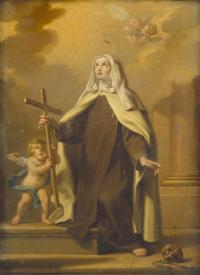
Feast day: 22 February
Margaret’s parents were farmers in Laviano, a small village nestled in the hills of Castiglione de Lago, about halfway between Montepulciano and Cortona. When she was seven, her mother died and her father remarried. Margaret and her new stepmother disliked each other. As she grew older she became wild and reckless and earned a bad reputation in the village. At the age of seventeen, she was seduced by a young knight and ran away with him. According to some accounts, he was the son of a local lord. Margaret was installed in a castle as his mistress and lived with him for nine years. During that time she had a son.
One day, when her lover failed to return from a visit to his estates, Margaret became worried. She became even more so when his favourite hound returned to the castle without him. The dog led her into the forest, where she found his body. He had been murdered. Margaret was very shaken by this event. She began to pray and do penance. She gave up her possessions, restoring to her lover’s family what was due. She arrived at her father’s house with her son and begged forgiveness. However, influenced by her stepmother, he refused to have her back. Instead she found refuge through the Franciscan friars at Cortona, who arranged for a place for herself and her son with two ladies. Her son went to school in Arezzo. He would later become a Franciscan.
Margaret undertook a regime of severe penance, starvation and self-mutilation. She was prevented from disfiguring her face by her confessor, as she wanted to make herself less attractive. Some of this mortification was unjustly extended to her son. A cottage was found for her and she earned money by caring for children and nursing sick ladies. After three years she was received into the Third Order of St Francis and entered into a mystical contemplation of Christ.
Margaret established a hospital for the sick, the homeless and impoverished. To attract nurses for the hospital and help look those imprisoned, she instituted a congregation of Tertiary sisters, known as La Poverelle (Little Poor Ones). She reported that while in prayer she had heard the words: “What is your wish, poverella?” (little poor one) and replied, “I neither seek nor wish for anything but you, my Lord Jesus.”
She established a congregation devoted to Our Lady of Mercy, members binding themselves to support the hospital and help the needy. She also gave counsel to penitents, who came to her as her reputation for sanctity spread.
She began sleeping on a wooden trellis in a cell in the Church of St Francesco, cared for by the local Franciscan Convent, as it still is today. Once, on a Sunday morning, she made a public confession, with a full account of her past, and begged forgiveness from the community of her childhood.
Margaret became involved in the Guelph/Ghibelline dispute, which divided local families (the Guelphs supported the Pope, the Ghibellines the Holy Roman Emperor; the conflict, to put it simply, was about who had the right to invest a prelate). She was asked to seek for reconciliation between the factions. She also reprimanded the Bishop of Arrezzo publicly, about the way he lived and his going to war like a secular ruler rather than a cleric.
By 1288, Margaret had devoted herself to contemplation, among the ruins of a small oratory dedicated to St Basilio. Apart from the visits of the priest she lived alone. The little church had been damaged during the 1258 siege of the town by soldiers from Arezzo. Margaret led efforts to rebuild the church and the adjacent convent. She was laid in a wall of the chapel of St Basilio when she died in February 1297. She was not yet fifty. She was immediately acclaimed a saint but was not officially canonised till 1728.
By 1330, from a design by Giovanni Pisano, the citizens of Cortona constructed a basilica, Santa Margerita, which can been seen today. The old church was now subsumed into the nave of the newer one. In the third altar to the left of the nave is the place where Margaret died, in a room behind the old church, where she had lived for the last years of her life.
In 1456, Margaret’s body was exhumed and was found to be incorrupt. It is now housed in the basilica, where it can be seen in a silver casket. She was canonised by Pope Benedict XIII. She is often pictured with the dog which led her to the body of her murdered lover.
St Margaret of Cortona, pray for us.